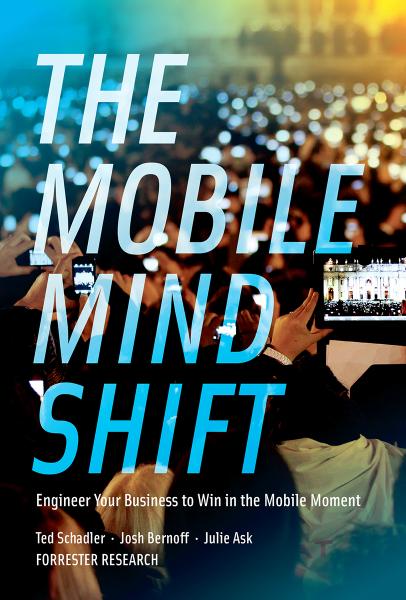Why You Should Read The Mobile Mind Shift
 Worldwide, people use mobile devices pretty much continuously. Mobile access on smartphones and tablets creates a dramatic change in behavior as people use, then expect, and then demand service from every entity they deal with. This is the mobile mind shift:
Worldwide, people use mobile devices pretty much continuously. Mobile access on smartphones and tablets creates a dramatic change in behavior as people use, then expect, and then demand service from every entity they deal with. This is the mobile mind shift:
The mobile mind shift is the expectation that I can get what I want in my immediate context and moments of need.
Despite this complete transformation in expectations, companies typically have no idea what to do about it. "I guess we should build an app," they tell us. Instead, this transformation demands a complete rethink of the way they do business. Business competition has now focused down to the mobile moment — the point in time and space when someone pulls out a mobile device to get what he or she wants immediately, in context. Win in that moment, and you have his or her loyalty. Fail to be there, or screw it up, and an entrepreneur will do a better job and steal your customer.
Getting mobile right will require you to change how you see customers, your relationship with those customers, and (the expensive part) the platforms, people, and processes that power those systems. When mobile engagement fails, it's usually because companies didn't recognize the scope of what they need to get that mobile moment right. They need a mobile mind shift of their own.
This need is so great — and so counterintuitive to get right — that we had to write a book to help. That book, The Mobile Mind Shift, is available right now on Kindle, Nook, and Google Play. (It's less than $5 for now — go ahead, take advantage of us.)
We have a lot to say in this book, but here are a few things that may make a difference to you as you plan your mobile strategy.

- Three of us wrote this book. Ted Schadler is our expert on the mobile strategy and the business technology that powers mobile engagement — the real challenge of mobile. Julie Ask is our expert on strategy for mobile customer interactions and has worked with hundreds of clients on it. I contributed expertise on consumers and data and helped pull the thing together into a coherent whole. Behind us are dozens of Forrester mobile experts on everything from Asian consumers to application development to mobile marketing to customer experience. There's a lot of Forrester's intelligence behind this one.
- It's crammed with case studies. There are over 30 case studies and hundreds of detailed examples from the Americas, Europe, Asia, Australia, and Africa, in industries ranging from apparel and restaurants to business services and travel. Want to hear from companies like Starbucks, Dish Network, American Airlines, USAA, ING Bank, and Nordstrom? We interviewed over 200 people, and many of their stories are in here. Writing this book was like being in a room filled with the most interesting people who've ever worked on and triumphed over mobile challenges. Reading it will make you feel the same way.
- It tells the whole mobile story. We've revealed the strategic framework that was common to nearly every company we talked to. We've got stats on mobile intensity and expectation worldwide. We have chapters on sales, marketing, mobile-enhanced products, and business models. The whole back half of the book is dedicated to the implications for workforce, platforms, processes, and development methods. It's comprehensive.
The print book won't be available until June 24, but you can read this now as an eBook. I am more excited about this content than I have been since Groundswell six years ago. This is the biggest challenge most companies face right now, and we put in the work to give you what you need to really understand it and succeed with mobile engagement. All yours for five bucks. Let me know what you think.